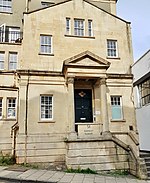Dulcie Mary Pillers
Dulcie Mary was born on 17 August 1891,[1] at Glen Gariff, Chesterfield Road, St Andrew's, Bristol,[2] the second daughter of Ernest James Pillers and Elizabeth Scott, née Webb.
In 1898, he was charged with forging shares in the Fishponds and Bedminster Brick and Tile Company and obtaining transfer deeds by false pretences,[14] though the case was settled the following year.
[4]: 456–457 In 1906, Pillers began corresponding with the "Children's Corner" section in the Bristol Times and Mirror,[21] that was edited by Florence Beatrice Hawkins, née Bird.
[26] He worked for Morgan and Wood, automobile engineers at 7 Unity Street, Bristol,[27][e] before being called-up to the Northamptonshire Regiment at the start of World War I.
[48] In December 1921, John Fisher retired through ill health,[49] and a year later, the school was closed permanently because of dwindling pupil numbers and escalating costs.
[50] By 1918, Pillers was employed as a secretary and medical illustrator to Ernest William Hey Groves,[53] a well-known orthopaedic surgeon.
[4]: 457 [i] He was commissioned captain in the Royal Army Medical Corps in World War I,[55]: 138 serving for a year at the surgical division of a general hospital in Alexandria, Egypt.
[57][j] The war was one of the most destructive conflicts in human history, leaving over 750 thousand British troops dead with 1.6 million injured, the majority with orthopaedic injuries.
[61]: Preface [l] From January 1916, Cecil Gwendolen St Leger Russell worked with Hey Groves at Beaufort and Southmead Hospital as a "surgical draughtswoman",[67] illustrating his 1918 paper on the treatment of gunshot injuries to bone.
[68][m] Pillers, with Russell, illustrated Hey Groves's first post-armistice paper, "The Crucial Ligaments of the Knee‑joint", published in the January 1919 edition of the British Journal of Surgery.
[69] In December 1918, Russell married Niel Charles Trew, an American physician, born in Toronto,[70] who had worked at Beaufort during the war.
[71][n] In March 1919, the Trews left Bristol for New York, and in consequence, Pillers became the sole medical illustrator to Hey Groves.
[72] She contributed to a number of papers on rheumatic and coronary artery diseases by Carey Coombs,[73] including the 1926 Long Fox Memorial Lecture.
[78] She continued to contribute to her colleague's medical papers, including sketches of bone cross-sections, that exhibited the typical features of renal rickets.
[79] I have to express my grateful thanks to Miss Pillers for the care and skill she has bestowed upon the preparation of the illustrations, which form, I think, its most valuable feature.
Hey Groves died on 22 October 1944,[80] and in recognition of Pillers' "long and devoted service", he left her his casebooks and copyright in Synopsis of Surgery.
[81] On 2 April 1949, she attended the founding meeting of the Medical Artists' Association of Great Britain at Nunnery Close, Upper Wolvercote, Oxford, the then home of Audrey Arnott and Margaret McLarty.
[105] Marrian was a qualified doctor, a former research fellow at the Memorial Sloan Kettering Cancer Center,[106] and until her retirement, director of medical studies at Girton College, Cambridge.

